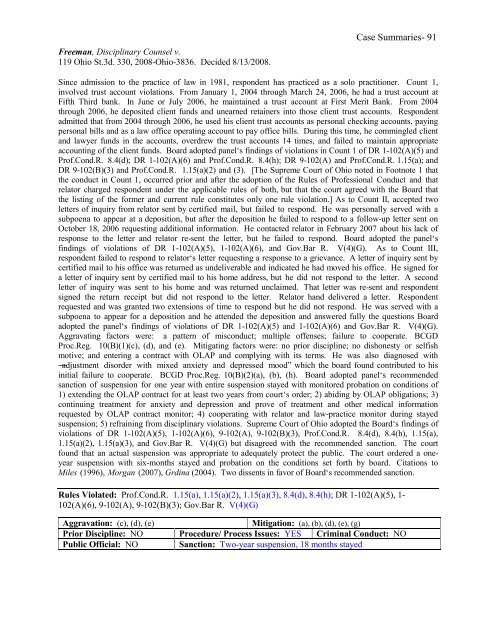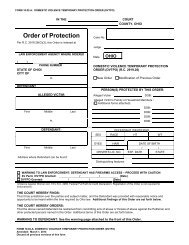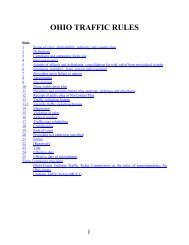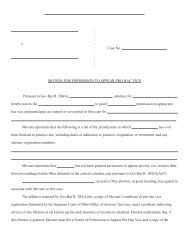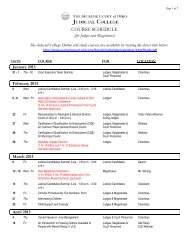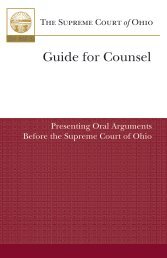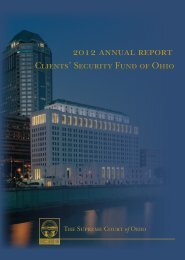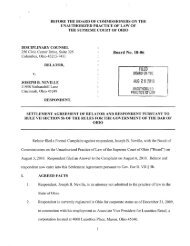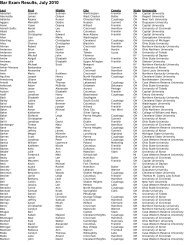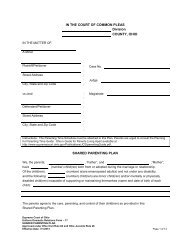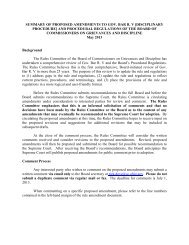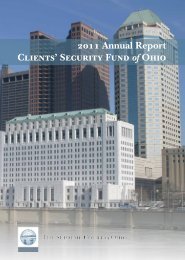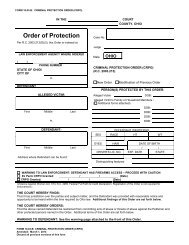disciplinary handbook: volume v - Supreme Court - State of Ohio
disciplinary handbook: volume v - Supreme Court - State of Ohio
disciplinary handbook: volume v - Supreme Court - State of Ohio
Create successful ePaper yourself
Turn your PDF publications into a flip-book with our unique Google optimized e-Paper software.
Freeman, Disciplinary Counsel v.119 <strong>Ohio</strong> St.3d. 330, 2008-<strong>Ohio</strong>-3836. Decided 8/13/2008.Case Summaries- 91Since admission to the practice <strong>of</strong> law in 1981, respondent has practiced as a solo practitioner. Count 1,involved trust account violations. From January 1, 2004 through March 24, 2006, he had a trust account atFifth Third bank. In June or July 2006, he maintained a trust account at First Merit Bank. From 2004through 2006, he deposited client funds and unearned retainers into those client trust accounts. Respondentadmitted that from 2004 through 2006, he used his client trust accounts as personal checking accounts, payingpersonal bills and as a law <strong>of</strong>fice operating account to pay <strong>of</strong>fice bills. During this time, he commingled clientand lawyer funds in the accounts, overdrew the trust accounts 14 times, and failed to maintain appropriateaccounting <strong>of</strong> the client funds. Board adopted panel‘s findings <strong>of</strong> violations in Count 1 <strong>of</strong> DR 1-102(A)(5) andPr<strong>of</strong>.Cond.R. 8.4(d); DR 1-102(A)(6) and Pr<strong>of</strong>.Cond.R. 8.4(h); DR 9-102(A) and Pr<strong>of</strong>.Cond.R. 1.15(a); andDR 9-102(B)(3) and Pr<strong>of</strong>.Cond.R. 1.15(a)(2) and (3). [The <strong>Supreme</strong> <strong>Court</strong> <strong>of</strong> <strong>Ohio</strong> noted in Footnote 1 thatthe conduct in Count 1, occurred prior and after the adoption <strong>of</strong> the Rules <strong>of</strong> Pr<strong>of</strong>essional Conduct and thatrelator charged respondent under the applicable rules <strong>of</strong> both, but that the court agreed with the Board thatthe listing <strong>of</strong> the former and current rule constitutes only one rule violation.] As to Count II, accepted twoletters <strong>of</strong> inquiry from relator sent by certified mail, but failed to respond. He was personally served with asubpoena to appear at a deposition, but after the deposition he failed to respond to a follow-up letter sent onOctober 18, 2006 requesting additional information. He contacted relator in February 2007 about his lack <strong>of</strong>response to the letter and relator re-sent the letter, but he failed to respond. Board adopted the panel‘sfindings <strong>of</strong> violations <strong>of</strong> DR 1-102(A)(5), 1-102(A)(6), and Gov.Bar R. V(4)(G). As to Count III,respondent failed to respond to relator‘s letter requesting a response to a grievance. A letter <strong>of</strong> inquiry sent bycertified mail to his <strong>of</strong>fice was returned as undeliverable and indicated he had moved his <strong>of</strong>fice. He signed fora letter <strong>of</strong> inquiry sent by certified mail to his home address, but he did not respond to the letter. A secondletter <strong>of</strong> inquiry was sent to his home and was returned unclaimed. That letter was re-sent and respondentsigned the return receipt but did not respond to the letter. Relator hand delivered a letter. Respondentrequested and was granted two extensions <strong>of</strong> time to respond but he did not respond. He was served with asubpoena to appear for a deposition and he attended the deposition and answered fully the questions Boardadopted the panel‘s findings <strong>of</strong> violations <strong>of</strong> DR 1-102(A)(5) and 1-102(A)(6) and Gov.Bar R. V(4)(G).Aggravating factors were: a pattern <strong>of</strong> misconduct; multiple <strong>of</strong>fenses; failure to cooperate. BCGDProc.Reg. 10(B)(1)(c), (d), and (e). Mitigating factors were: no prior discipline; no dishonesty or selfishmotive; and entering a contract with OLAP and complying with its terms. He was also diagnosed with―adjustment disorder with mixed anxiety and depressed mood‖ which the board found contributed to hisinitial failure to cooperate. BCGD Proc.Reg. 10(B)(2)(a), (b), (h). Board adopted panel‘s recommendedsanction <strong>of</strong> suspension for one year with entire suspension stayed with monitored probation on conditions <strong>of</strong>1) extending the OLAP contract for at least two years from court‘s order; 2) abiding by OLAP obligations; 3)continuing treatment for anxiety and depression and prove <strong>of</strong> treatment and other medical informationrequested by OLAP contract monitor; 4) cooperating with relator and law-practice monitor during stayedsuspension; 5) refraining from <strong>disciplinary</strong> violations. <strong>Supreme</strong> <strong>Court</strong> <strong>of</strong> <strong>Ohio</strong> adopted the Board‘s findings <strong>of</strong>violations <strong>of</strong> DR 1-102(A)(5), 1-102(A)(6), 9-102(A), 9-102(B)(3), Pr<strong>of</strong>.Cond.R. 8.4(d), 8.4(h), 1.15(a),1.15(a)(2), 1.15(a)(3), and Gov.Bar R. V(4)(G) but disagreed with the recommended sanction. The courtfound that an actual suspension was appropriate to adequately protect the public. The court ordered a oneyearsuspension with six-months stayed and probation on the conditions set forth by board. Citations toMiles (1996), Morgan (2007), Grdina (2004). Two dissents in favor <strong>of</strong> Board‘s recommended sanction.Rules Violated: Pr<strong>of</strong>.Cond.R. 1.15(a), 1.15(a)(2), 1.15(a)(3), 8.4(d), 8.4(h); DR 1-102(A)(5), 1-102(A)(6), 9-102(A), 9-102(B)(3); Gov.Bar R. V(4)(G)Aggravation: (c), (d), (e)Mitigation: (a), (b), (d), (e), (g)Prior Discipline: NO Procedure/ Process Issues: YES Criminal Conduct: NOPublic Official: NO Sanction: Two-year suspension, 18 months stayed


